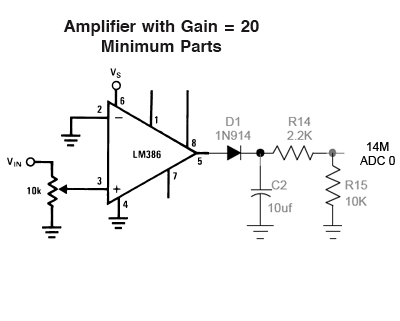I am attempting to create servo movement based on the sound level at an ADC. I am currently using my computer’s 1/8” audio out. I am getting pretty decent results in the 0-30 range. I would like better resolution.
I built a simple LM386 circuit with the stock 20x gain. This caused my debug window to disappear from time to time. I am guessing it was too much amplification.
I read through the forums and found lots of great op-amp information but even with some modifications to my circuit to include a 10k pot for input volume control I was getting poor results and when an 8ohm speaker was connected I was hearing loads of noise!
As a side note… I have also been working on using electret microphones and LM741/LM386 preamp’d and non preamp’d with little success.
Does anyone have a tested, working circuit?
I even went so far as to buy breakout boards from Spark Fun. They don’t work the way I expected and Spark Fun seems to think it is a problem with the A2D converters and that I should use the chip they used for testing.
Any help would be great!
Thanks!
Corey
I built a simple LM386 circuit with the stock 20x gain. This caused my debug window to disappear from time to time. I am guessing it was too much amplification.
I read through the forums and found lots of great op-amp information but even with some modifications to my circuit to include a 10k pot for input volume control I was getting poor results and when an 8ohm speaker was connected I was hearing loads of noise!
As a side note… I have also been working on using electret microphones and LM741/LM386 preamp’d and non preamp’d with little success.
Does anyone have a tested, working circuit?
I even went so far as to buy breakout boards from Spark Fun. They don’t work the way I expected and Spark Fun seems to think it is a problem with the A2D converters and that I should use the chip they used for testing.
Any help would be great!
Thanks!
Corey
Last edited:



